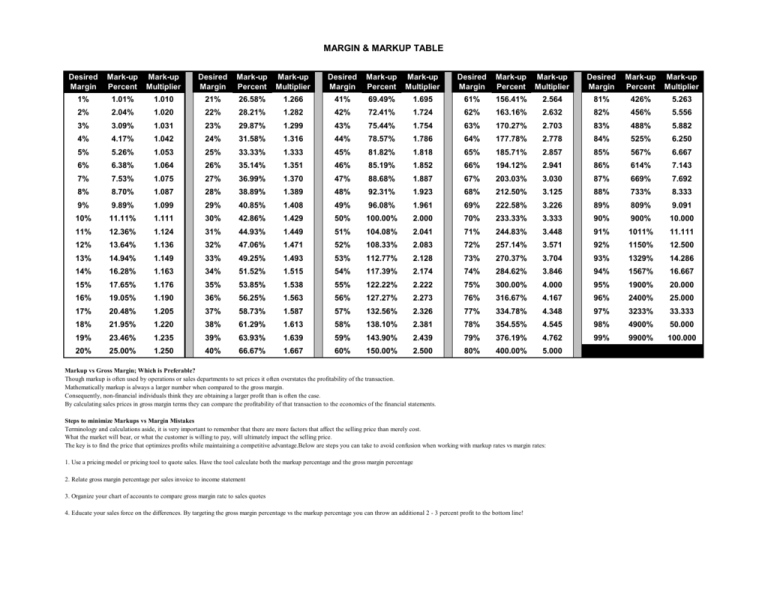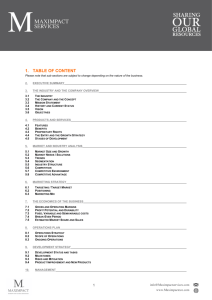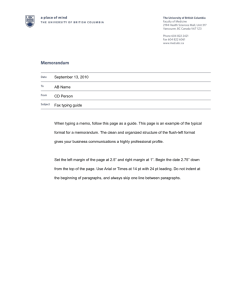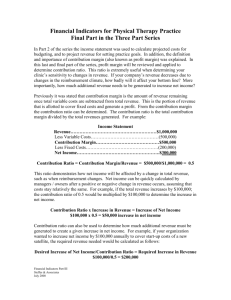Margin & Markup Table: Business Pricing Guide
advertisement

MARGIN & MARKUP TABLE Desired Margin Mark-up Percent Mark-up Multiplier Desired Margin Mark-up Percent Mark-up Multiplier Desired Margin Mark-up Percent Mark-up Multiplier Desired Margin Mark-up Percent Mark-up Multiplier Desired Margin Mark-up Percent Mark-up Multiplier 1% 1.01% 1.010 21% 26.58% 1.266 41% 69.49% 1.695 61% 156.41% 2.564 81% 426% 5.263 2% 2.04% 1.020 22% 28.21% 1.282 42% 72.41% 1.724 62% 163.16% 2.632 82% 456% 5.556 3% 3.09% 1.031 23% 29.87% 1.299 43% 75.44% 1.754 63% 170.27% 2.703 83% 488% 5.882 4% 4.17% 1.042 24% 31.58% 1.316 44% 78.57% 1.786 64% 177.78% 2.778 84% 525% 6.250 5% 5.26% 1.053 25% 33.33% 1.333 45% 81.82% 1.818 65% 185.71% 2.857 85% 567% 6.667 6% 6.38% 1.064 26% 35.14% 1.351 46% 85.19% 1.852 66% 194.12% 2.941 86% 614% 7.143 7% 7.53% 1.075 27% 36.99% 1.370 47% 88.68% 1.887 67% 203.03% 3.030 87% 669% 7.692 8% 8.70% 1.087 28% 38.89% 1.389 48% 92.31% 1.923 68% 212.50% 3.125 88% 733% 8.333 9% 9.89% 1.099 29% 40.85% 1.408 49% 96.08% 1.961 69% 222.58% 3.226 89% 809% 9.091 10% 11.11% 1.111 30% 42.86% 1.429 50% 100.00% 2.000 70% 233.33% 3.333 90% 900% 10.000 11% 12.36% 1.124 31% 44.93% 1.449 51% 104.08% 2.041 71% 244.83% 3.448 91% 1011% 11.111 12% 13.64% 1.136 32% 47.06% 1.471 52% 108.33% 2.083 72% 257.14% 3.571 92% 1150% 12.500 13% 14.94% 1.149 33% 49.25% 1.493 53% 112.77% 2.128 73% 270.37% 3.704 93% 1329% 14.286 14% 16.28% 1.163 34% 51.52% 1.515 54% 117.39% 2.174 74% 284.62% 3.846 94% 1567% 16.667 15% 17.65% 1.176 35% 53.85% 1.538 55% 122.22% 2.222 75% 300.00% 4.000 95% 1900% 20.000 16% 19.05% 1.190 36% 56.25% 1.563 56% 127.27% 2.273 76% 316.67% 4.167 96% 2400% 25.000 17% 20.48% 1.205 37% 58.73% 1.587 57% 132.56% 2.326 77% 334.78% 4.348 97% 3233% 33.333 18% 21.95% 1.220 38% 61.29% 1.613 58% 138.10% 2.381 78% 354.55% 4.545 98% 4900% 50.000 19% 23.46% 1.235 39% 63.93% 1.639 59% 143.90% 2.439 79% 376.19% 4.762 99% 9900% 100.000 20% 25.00% 1.250 40% 66.67% 1.667 60% 150.00% 2.500 80% 400.00% 5.000 100% Markup vs Gross Margin; Which is Preferable? Though markup is often used by operations or sales departments to set prices it often overstates the profitability of the transaction. Mathematically markup is always a larger number when compared to the gross margin. Consequently, non-financial individuals think they are obtaining a larger profit than is often the case. By calculating sales prices in gross margin terms they can compare the profitability of that transaction to the economics of the financial statements. Steps to minimize Markups vs Margin Mistakes Terminology and calculations aside, it is very important to remember that there are more factors that affect the selling price than merely cost. What the market will bear, or what the customer is willing to pay, will ultimately impact the selling price. The key is to find the price that optimizes profits while maintaining a competitive advantage.Below are steps you can take to avoid confusion when working with markup rates vs margin rates: 1. Use a pricing model or pricing tool to quote sales. Have the tool calculate both the markup percentage and the gross margin percentage 2. Relate gross margin percentage per sales invoice to income statement 3. Organize your chart of accounts to compare gross margin rate to sales quotes 4. Educate your sales force on the differences. By targeting the gross margin percentage vs the markup percentage you can throw an additional 2 - 3 percent profit to the bottom line! 200.000









